
CROXLEY GREEN TRIANGULAR JUNCTION
AND DEPOT
The London and Birmingham Railway opened its line between London Euston and Boxmoor (Hemel Hempstead) on 20 July 1837 with intermediate stations at Harrow and Watford. The original station in Watford was north of St Albans Road. In 1846 the London and Birmingham Railway, the Grand Junction Railway and the Manchester and Birmingham Railway merged to form the London & North Western Railway.
Watford station was renamed Watford Junction and resited to its present site when the line to St Albans opened, joining the main line south of St Albans Road, on 5 May 1858
In July 1860 the Watford & Rickmansworth Railway obtained powers to construct a 4½-mile single-track line between Watford Junction and Rickmansworth. This line opened on 1 October 1862 with one intermediate station at Watford High Street.

A scheme to electrify services between London and Watford was first suggested in 1907. Worried by the growing influence of the Metropolitan Railway in north-west London, the LNWR added a short branch line to Croxley Green under the New Lines Act. Works commenced in 1908 and the line opened on 15 June 1912 from Croxley Green Junction on the Rickmansworth branch. At this time the line between Croxley Green Junction and Watford Junction was substantially rebuilt as a double-track formation forming part of the LNWR’s ambitious London suburban electrification scheme which was announced in 1911 after the LNWR took over the management of the North London Railway.
As part of this scheme, a new suburban line would was built alongside the main line from Camden Junction as far as Bushey & Oxhey where it diverged from the main London – Watford line and, in a wide sweep, crossed the Colne Valley to reach High Street Junction on the Rickmansworth line 250yd south-west of Watford High Street station. There was a temporary junction for a short period at Kensal Green Tunnel mouth where the new line joined the slow line while Kensal Green and Primrose Hill new line tunnels were being built. Kensal Green Tunnel, at least, was open by 1917 ready for the introduction of the Bakerloo service through to Watford Junction.

Looking towards Colne Junction which is obscured by trees in 1913 from Bushey sub-station, which stood alongside the north end of the up new line platform at Bushey & Oxhey station and is Benskin's Watford brewery building is on the skyline in the background. This view is taken shortly after the line was completed but before it was electrified.
green_junction.jpg) Croxley Green Junction and depot in 1921. The depot is seen in the centre. Croxley Green triangular junction is to the north of the depot with the Croxley Green Curve to the right and the Watford line to the left. In the bottom half of the picture the Rickmansworth branch is to the right with the Croxley Green branch to the left. Click to enlarge.
Croxley Green Junction and depot in 1921. The depot is seen in the centre. Croxley Green triangular junction is to the north of the depot with the Croxley Green Curve to the right and the Watford line to the left. In the bottom half of the picture the Rickmansworth branch is to the right with the Croxley Green branch to the left. Click to enlarge.
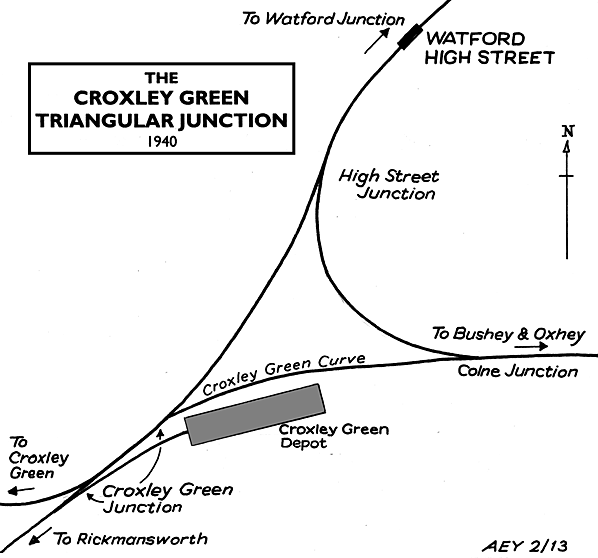
Drawn
by Alan Young
With the completion of the final section of the new line between Harrow & Wealdstone and High Street Junction on the Rickmansworth branch, the line was opened for steam operation on 10 February 1913, with electric trains operating from 16 April 1917 when the Bakerloo line was extended from Queens Park to Watford Junction via the new Bushey Curve and Watford High Street. Although the operation of the new line was mostly self-contained, connections at Watford Junction and Camden allowed other trains on to it, a facility used occasionally with trains diverted from the West Coast main line should an alternative diversionary route be not available.
The LNWR ran a steam service along the new line using the junction at Kensal Green Tunnel mouth until Primrose Hill Tunnel and electrification between Queens Park and Euston were complete. Main line services on this line began when the LNWR completed the Camden to Watford Junction new line on 10 July 1922, with new electric multiple units (EMU) providing the motive power on the new service between Euston and Watford.
The motor cars were built by Metropolitan Carriage Wagon & Finance Co. while the trailers and driving trailers came from Wolverton works. The electrical equipment for the new trains was built by the Swiss company Maschinenfabrik Oerlikon. In 1927 the Oerlikon units were joined by 'compartment stock' which had GEC electrical equipment. Units of this type were also provided for the electrification of lines serving Liverpool Exchange. A further batch was delivered in 1932, identical to the 1927 batch, although constructed by different builders
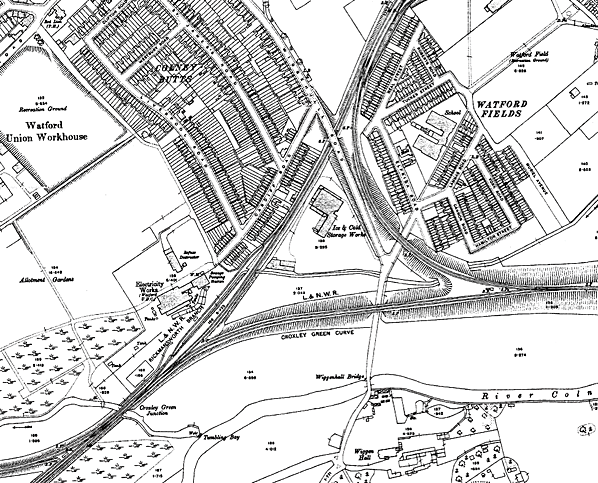
1914 1:2,500 OS map surveyed before the depot was built. Click to enlarge
1939 1:2,500 OS map. Click to enlarge
The construction of the new lines in the Watford area included a triangular junction with a spur enabling trains from Croxley Green or Rickmansworth to run south to Bushey and on to London via the new Croxley Green Curve although, in practice, this service only ever ran from Croxley Green. The western end of the curve retained the name Croxley Green Junction and included the junction between the Croxley Green and Rickmansworth branches. The eastern end of the curve became Colne Junction. A substantial new depot, known as Croxley Green sheds or depot, was built to the south of the curve adjacent to Croxley Green Junction to house the new electric trains. It opened on 16 April 1917 when the Bakerloo line was extended.
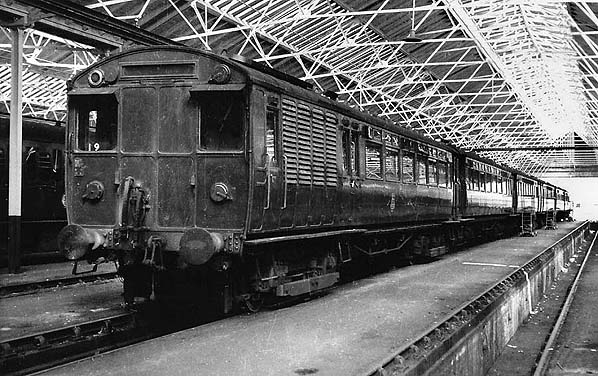 An aging Oerlikon EMU in Croxley Green shed in the late 1950s. A class-501 EMU is
An aging Oerlikon EMU in Croxley Green shed in the late 1950s. A class-501 EMU is
seen in the background.
Oerlikon saloon stock replaced steam on the Croxley Green branch on 30 October 1922. This marked the final stage of the LNWR’s London suburban electrification, just two months before the LNWR became part of the London Midland & Scottish (LMS) Railway on 1 January 1923. Although it was always intended that the Rickmansworth branch would be electrified as part of the North Western Electrics scheme it had to wait until September 1927 when it was electrified by the LMS using an existing sub-station at Bushey.
To operate services north of Queens Park, 72 additional cars were built by the Metropolitan Carriage, Wagon and Finance Company of Birmingham. These trains, known as the Watford Joint Stock, were partly owned by the Underground and partly by the London & North Western Railway; they were initially painted in LNWR livery. They were not equipped with air-operated doors and proved slow and unreliable, so they were replaced with new trains of standard stock in 1930. Nine of the 72 joint cars were transferred to the Croxley Green and Rickmansworth branches because the full size electric cars used on both branches were putting an excessive load on the Bushey sub-station. In 1939 the tube stock was withdrawn and replaced with spare main line Oerlikon stock
curve1.jpg) The Croxley Green Junction - Colne Junction Curve seen from a window of the 8.01 am Croxley Green - Euston train on 20 February 1960. Croxley Green depot is on the right.
The Croxley Green Junction - Colne Junction Curve seen from a window of the 8.01 am Croxley Green - Euston train on 20 February 1960. Croxley Green depot is on the right.
Photo
by David Pearson
The depot was shared by the Bakerloo Line and the LMS for stock on the small self-contained group of lines, which was electrified at 630V DC on the 3rd and 4th rail principle, linking London Euston to Watford, Broad Street with both Richmond and Watford plus the Croxley Green branch — which was served mostly by shuttle trains from Watford. Some of these services were partially jointly operated with London Underground's Bakerloo and District Lines. Initially the service was provided by Oerlikon stock but from 1957 (the last unit was withdrawn in April 1959) these were replaced with Class 501 EMUs built at BR’s Eastleigh Works. The compartment stock was finally withdrawn in 1963, largely as a result of timetable service reductions.
The original electric scheme on these lines was at 630V DC, which was actually supplied at +420V in the outer electric rail and -210V in the centre one, a total potential difference of 630V. This was the same system as used at the time (and still employed today) by London Underground, and allowed Underground trains to run over the lines, from Queens Park to Watford (Bakerloo Line) and Gunnersbury to Richmond (District Line). In 1970 it was decided to convert to the normal arrangement of the full positive current of +630V in the outer rail, and to use the normal running rails for the return current at 0 potential. This required adaptation of the Class 501 trains to return current through the wheels instead of the centre rail. On the sections shared with the Underground trains the centre rail was retained, but was now also at zero potential and just bonded electrically to the running rails.
curve3.jpg)
The evening Broad Street - Croxley Green train passes Colne Junction heading for Croxley Green Junction on 27 May 1966.
Photo
by David Pearson
The Croxley Green Curve was also used by the Bakerloo line stores train which ran weekly from Neasden depot, as until c1965 Croxley Green was a ‘proper’ depot rather than a mere stabling point for Bakerloo trains. Another use for the curve was in connection with sporting events at Wembley in post-war years, specifically an annual hockey match. Passengers on trains from the Southern Region would alight at Wembley Central then the stock continued empty to Watford Junction where it would be stabled in the carriage shed which used to stand next to the St Albans branch. The engines, often coupled together, would run round the triangular junction to turn and be ready to take the stock back to Wembley for the return working. Watford MPD had a turntable but it was presumably too short for express passenger engines. The last occasion that this occurred, was 10 March 1962 when BB class no. 34108 brought a rake into Watford Junction and was turned on the triangle. Back in 1925, a Broad Street - Croxley Green service ran throughout the day in connection with the Wembley exhibition, even continuing for a year or so afterwards.
The Rickmansworth branch closed to passenger traffic on 3 March 1952 and to goods traffic on 2 January 1967 when the branch was cut back to Croxley Paper Mill. The mill closed in 1983 when the track was lifted back to Croxley Green Junction.
The Sunday service between Watford Junction and Croxley Green ran for the last time on 10 May 1959. At the timetable change of 7 September 1963 the Croxley Green Curve was illegally closed by BR. Prior to this there were one up Broad Street and one Euston trains on weekday mornings (including Saturdays) and one down Broad Street service on Mondays-to-Fridays; these were all withdrawn at that time. However from 18 November, on Mondays-to-Fridays, one up Broad Street train in the morning, and one down train from there in the evening were reinstated. This situation remained unchanged until 1966.
curve2.jpg)
Bakerloo train on the Croxley Green Junction to Colne Junction curve on 2nd May 1966. It is likely there was a problem the previous evening which precluded this train going through to Watford Junction, so it must have gone straight to depot from Bushey. It would be using the curve here so that it would not be the 'wrong way round' for service.
Photo
by David Pearson
The last passenger service used the Croxley Green Curve on 3 June 1966, so the closure date for passenger traffic was 6 June 1966. It closed to all traffic on 19 September 1966. One would think that there would be no traffic at all after the withdrawal of the passenger service, but one thing that the curve must have been used for was the turning of EMUs. From the start of this electrification up to the summer of 1966 all six-car trains - and most workings were six cars - had the motor cars marshalled at the outer ends. From some time in 1966 however, all units had the motor cars at the London end of the train. The Croxley Green triangle was the only place on the system where the units could be turned and, once the curve had gone, all trains remained the same way round.
The stabling of four Bakerloo trains overnight at Croxley Green depot was continued until 1982 because of a lack of stabling space elsewhere on the Bakerloo line. It was the opening of the Jubilee Line and the construction of Stonebridge Park Bakerloo depot, on the site of the LNWR power station, which enabled the Bakerloo to move out of Croxley Green depot and thus cease to run to Watford Junction.
curve1.jpg)
Bakerloo train between Colne Junction and High Street Junction in May 1966. Colne Junction signal box is visible above the houses to the left of the pylon.
Photo
by David Pearson
depot2.jpg) Inside the car sheds. As there were no conductor rails in the shed the trains were powered by trolley leads which ran in an overhead track. A set can be seen hanging up on the left. The photographer was privileged to ride out of the depot on the occasion of this photo. The guard plugged the leads into the receptacle on the train, and when the air had built up the driver took a short notch of power so the train travelled at about 1 mph. The guard then unplugged the leads, hung them up and hopped onto the train which continued coasting at about 1 mph until reaching the current rails outside the shed. Four Bakerloo trains were stabled here each night. These four trains were the only Bakerloo ones to run beyond Queens Park at the time. Stonebridge Park depot was opened at about this time, and later the service was extended to Harrow & Wealdstone. However in spring 1982 Bakerloo trains (four up in morning & four down in evening) ceased running to Watford Junction.
Photo
by David Pearson
The all-day Bakerloo service to Watford Junction was withdrawn in 1965. From this time six trains ran to Watford Junction in the evening rush hour and stabled overnight in Croxley Green depot, returning form Watford Junction to London during the following morning's rush hour. Subsequently this number of trains was reduced to four. This situation remained until 1982 when Stonebridge Park Bakerloo depot was opened, allowing the stabling of Bakerloo trains in Croxley Green depot and the consequent meagre service to Watford Junction to be dispensed with. The Bakerloo Line was cut back to Stonebridge Park station in 1982, although the service was restored as far as Harrow & Wealdstone in 1984
street_junction3.jpg)
L.C.G.B. (Croydon Branch) Southern & North London Electric Train Tour seen at High Street Junction from Wiggenhall Road on 8 November 1970. The junction signal box is seen in the background.
Photo
by David Pearson
The 501 units which were allocated to Croxley Green depot were due for withdrawal from operation in May 1985. The trains on the east-west orbital service, from Broad Street to Richmond, were replaced with Class 416 units from the Southern Region, from the first day of the service being diverted and extended from Broad Street around eastern London to North Woolwich station. Services between London Euston/Broad Street and Watford and on the Croxley Green branch were subsequently replaced with sliding door Class 313 units.
Although Croxley Green depot should have closed, there was a short stay of execution because of non-availability of Class 313 units. These were dragged to and from Hornsey depot for maintenance. There were often insufficient trains to operate the service and the 501s carried on a little longer. The situation was only really resolved when maintenance was transferred to Bletchley depot, to where the units could directly gain access by using their 25kv capability. Croxley Green depot eventually closed in November 1985. The depot was demolished in the late 1980s and, to date, the land has not been redeveloped
Croxley Green depot, with a selection of Class 501s and 313s in July 1985. Taken from the window of a train to Croxley Green.
Photo
by Jonathan Hazan from his Flickr photostream
depot1.jpg)
501 EMUs in Croxley Green depot in August 1981.
Photo
by David Pearson
In 1986 the Croxley Green branch found itself marketed as part of Network South East following the introduction of class 313 saloon stock and in 1988, an attempt was made to revive the fortunes of the branch by running a twice hourly daytime service. This optimism was, however, to be short lived. From 22 January 1990 the service was reduced to Monday to Friday peak hours and the 1993 timetable shows just one return morning journey.
In 1996 Hertfordshire County Council was allowed to break through the embankment short of Croxley Green station to build a new dual carriageway. This severed the line just east of the bridge over the River Gade/Grand Union Canal. The Croxley Green branch closed and a temporary bus service was introduced on 24 March 1996 with the intention of reinstating the rail service later that year.
junction17.jpg)
Croxley Green Junction and depot viewed from the LCGB / SEG First & Final 501 railtour on 11 May 1985. Taken opposite the site of the signal box and the junction of the Croxley Green and Rickmansworth branches.
Photo
by David Pearson
In about 1989 London Transport floated the idea of diverting the Metropolitan line away from its remote west Watford terminus and, by means of less than a mile of new alignment, link up with the Croxley Green branch to gain access to Watford Junction, this eventually became known as the 'Croxley Rail Link'.
In March 2001 the Strategic Rail Authority, in collaboration with Railtrack and Silverlink Trains Ltd, published a proposal to officially withdraw the service between Watford ]unction and Croxley Green in June that year and to close the line between High Street Junction and the terminus. The announcement concluded: "The closure of the Croxley Green branch would enable its use for that project.” It was stipulated that track and formation must remain intact for five years. At the time of writing track on the Croxley Green branch is intact although heavily overgrown. Construction work on the Croxley Rail link is expected to start in June 2014 and be finished by January 2016 when the northern side of the triangle will be brought back into use. Until then only one side of the triangle, the Bushey curve, linking Watford High Street with Bushey & Oxhey station remains in use.
depot17.jpg)
Croxley Green depot viewed from The 16.29 Watford Junction-Croxley Green train in February 1987, 14 months after the depot closed. Bridges 3 and 3A over the River Colne are seen. The rails leading to the headshunt have been lifted.
Photo
by David Warby from his Flickr photostream
junction7.jpg)
Looking towards the depot from bridge 3A over the River Colne in February 2013.
Photo
by Nick Catford
Aerial view from the late 2000s showing the site of the triangular junction and the depot. The Colne Junction - High Street Junction curve is to the right; this is the only part of the triangle still in use, The Croxley Green branch is to the left; the track is still in place but the line has been out of use since March 1996. This track will be re-laid for the Croxley Rail Link which is planned to open in 2016. The course of Croxley Green Curve to the west of Wiggenhall Road is intact and wooded. The site of the depot to the south of the curve is clearly visible. The east end has been put to light industrial use. Click to enlarge Croxley Rail Link. Click to enlarge.
Click here for more photos of the triangular junction and depot
| Last
updated: Thursday, 18-May-2017 17:18:53 CEST |
© 1998-2013 Disused Stations
| |




green_junction.jpg)


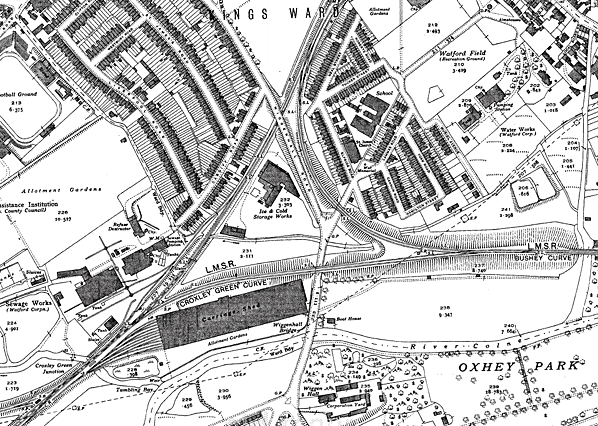

curve1.jpg)
curve3.jpg)
curve2.jpg)
curve1.jpg)
depot2.jpg)
street_junction3.jpg)
depot4.jpg)
depot1.jpg)
junction17.jpg)
depot17.jpg)
junction7.jpg)
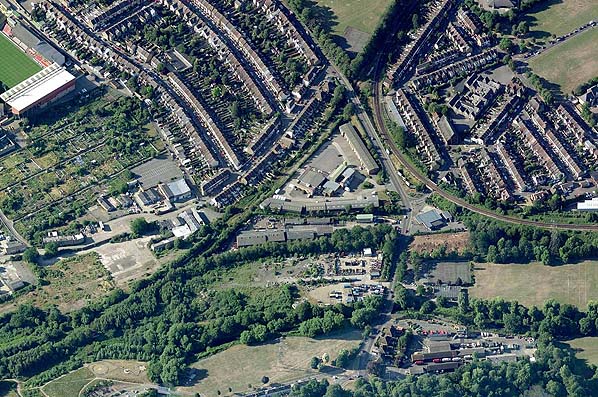
 Home Page
Home Page